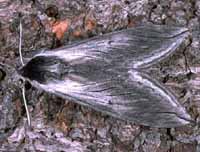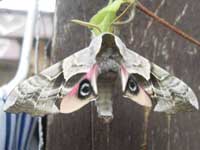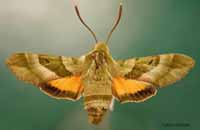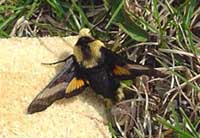Sphinginae subfamily
Sphingini tribe:
 |
This large bodied moth flies in tobacco fields and vegetable gardens
(potatoes, tomatoes) and wherever host plants are found. |
 |
Sphinx chersis WO, the Northern Ash
Sphinx or Great Ash Sphinx
The upperside of the forewing is soft dark gray to blue-gray with a series of black dashes,
one of which reaches the wing tip. |
 |
Sphinx perelegans adults fly in montane woodlands and mixed chaparral-type vegetation as a single brood
in the north, with adults mainly on the wing in June and July.
It flies from dusk until after midnight. |
 |
Snowberry Sphinx adults fly as a single brood in montane woodlands and along prairie
streamcourses from April to August.
The upperside of the forewing has a narrow black subterminal line
bordered by a white inverted V-shaped line on the outside, and a
black line at the apex. |
Smerinthini Tribe:
 |
The outer margin of the forewing is quite wavy. There is a dark cell spot and a dark oblique line mid wing from the costa almost to the
inner margin. Basic ground colour is pinkish brown. Flight would be June-July. |
 |
Smerinthus cerisyi WO, the Cerisyi's
Sphinx or One-eyed Sphinx, Larvae feed on poplars and willows.
Flight would be from late May-July as a single brood.
|
 | Larvae feed on poplars, aspen and willows.
Note different shape of double arced forewing pm line compared to the straighter pm line of cerisyi, directly above.
S. ophthalmica has smoother scalloping of the fw outer margin.
|
Macroglossinae subfamily
Dilophonotini tribe
 |
Hemaris thysbe USGS, the Hummingbird Clearwing,
Many gardeners mistake this moth for a small hummingbird as it
hovers, sipping nectar from flowers through a long feeding tube.
Flight is probably from late May-July and possibly again in the fall.
|
 |
Hemaris diffinis USGS, the Snowberry Clearwing or Bumblebee Moth,
The moth flies along forest edges and in meadows, gardens and
brushy fields. Day-flying adults nectar at lantana, dwarf bush honeysuckle,
snowberry, orange hawkweed, thistles, lilac, Canada violet, etc. |
Macroglossini tribe
 |
Hyles gallii WO, the Bedstraw Hawk Moth or Gallium Sphinx
Larvae feed on Epilobium angustifolium and Galium. I expect
flight is late May-July with a possible fall flight as well. |
 |
Hyles lineata USGS, the White-lined Sphinx
Adults usually fly at dusk, during the night, and at dawn, but they
also fly during the day over a wide variety of open habitats
including deserts, suburbs, and gardens. |
 |
Adults fly in the afternoon from April-June in oak woodland and
pine-oak woodland in foothills, nectaring from chia, heartleaf
milkweed, golden currant, bluedicks, fairyfans, vetches,
thistles, hedgenettles, etc. |
 | Proserpinus flavofasciata adults fly from
April-June in meadows in coniferous forests. Adults fly during the
afternoon, nectaring from lilac, dandelion, cherry, etc. |
|
|